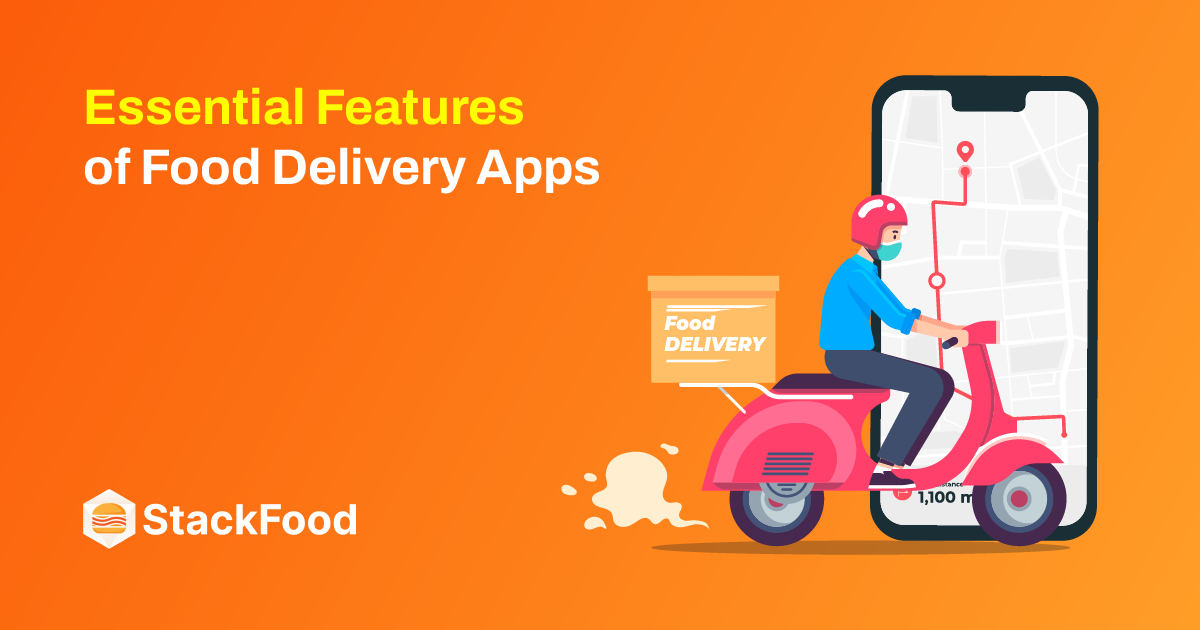The convenience of delivering food online has made the success of this industry skyrocketing. And there’s no good reason to be held back from starting a food delivery business or developing a food delivery app in this era.
But then this question naturally comes – “What are the essential food delivery app features?”
Well, this blog comes with the exact answer to that question with details to help you start your business in the food delivery industry or help you develop a food delivery app without missing out on anything important.
So let’s get into the details!
20 Must-Have Food Delivery App Features
The food delivery industry has witnessed tremendous growth in recent years, and with the advent of technology, several food delivery apps have emerged in the market. From FoodPanda to UberEats, DoorDash to Grubhub, each app offers unique features that cater to the customers’ specific needs.
However, with so many options available, it can be overwhelming for businesses or developers to decide which features to include in their apps.
To help you make an informed decision, we have compiled a list of essential and must-have features that can make your food delivery app stand out in the crowd. These features are crucial for the app’s success and cannot be ignored.
1. Multiple Login
Having multiple login options in your food delivery app offers several benefits. It enhances convenience by allowing users to choose their preferred login method: email, phone number, or social media accounts.
This ensures that all users, regardless of their preferences or accessibility needs, can easily access your app.
This feature is a must for faster sign-ups and streamlining the onboarding process. Also, having a guest login system within the login page lets users browse your app freely.
2. Customer Profile
Having a customer profile option within the food delivery app lets the customer edit their name, email, and address. Also, the profile section provides users with exclusive offers, discounts, and rewards based on their purchase history and activity within the app.
3. Language Setup
Allowing users to select and customize their language settings is crucial for making your app accessible and inclusive. Doing so can help you attract a wider user base and encourage engagement among non-native speakers.
Furthermore, offering multiple languages can greatly enhance your customer support services and improve communication between users and your food delivery business. By prioritizing language accessibility, you can create a more welcoming and user-friendly experience for everyone.
4. Social Media Integration
Social media integration has revolutionized the way mobile apps interact with their users. This saves time and reduces the frustration of remembering multiple login credentials.
Moreover, social media integration allows users to share app content and experiences with friends and family easily. This promotes the app and creates a sense of community around it. Users can share their achievements, high scores, and other interesting app-related content on their social media profiles, attracting potential users to download and use the app.
5. Location Setup
Setting up the current location gives customers a personalized experience by recommending location-based restaurants and food courts. For a food delivery app, it facilitates efficient route optimization and navigation.
Users of the app can turn on their phone’s location or choose their location using Google Maps for better navigation and experience.
6. Push Notifications
Push notifications are a great way for users to stay updated on order status, delivery times, and promotions in real time. They help remind your users to complete transactions or take specific actions, which can increase your order frequency.
By integrating push notifications into your app, you can send personalized offers, discounts, and recommendations based on app users’ preferences and behaviors. This can enable targeted marketing and make the user’s experience more enjoyable and convenient.
7. Search Bar
If you want your users to have a smooth experience searching for their preferred restaurants, cuisines, or specific dishes, you can’t afford to miss out on this feature. Besides saving your users’ time and effort, it also helps keep them happy and returning to your platform.
In addition, it gives you valuable insights into your users’ behavior and preferences. This helps you to optimize your offerings and marketing strategies, ultimately leading to better business decisions and increased success.
8. Favorite Items
Users can save their preferred dishes for quick access in the future using this feature. It gives users the maximum flexibility to re-order and easy navigation through the application.
As a result, the Favorite Item feature can increase user satisfaction, retention, and overall business growth within the food delivery app ecosystem.
9. Order Tracking
This feature lets the customer track orders every step of the way. From the order being placed to delivery, they get to see real-time visibility into the status of their orders. This transparency enhances the overall user experience by reducing uncertainty.
Incorporating this feature also enables restaurants to proactively address any issues or delays that may arise during the delivery process.
10. Order History
It allows access to past orders to find details like order items, prices, and delivery statuses. This helps users quickly reorder their favorite meals or view their purchasing history for budgeting and planning purposes.
For businesses, order history provides valuable insights into customer preferences and behavior.
Also Read: Build a Food Delivery App Like Uber Eats
11. Secure Payment Options
If you want to keep your customers’ financial information safe, it’s important to have secure payment options in your food delivery app. Using encrypted payment gateways and tokenization. You can ensure that users can store their payment details without worrying about unauthorized access or fraud. This makes the checkout process smoother and encourages users to make repeat purchases. Ultimately, it enhances their overall satisfaction to the app user.
12. Order Scheduling
With this feature, your customers can plan their orders in advance based on their schedules and avoid peak hours or long waiting times. This means they’ll have a better overall experience with the app.
But it’s not just your customers who benefit – your business can too. You can allocate resources more effectively and reduce delivery costs by efficiently managing order volumes and planning delivery routes. This, in turn, means faster delivery times and increased flexibility.
13. Ratings & Reviews
By checking the ratings and reviews of other customers on your app, people can easily decide where to order from. This helps ensure they have a good experience every time.
This feature is particularly useful as it gives insights into factors such as food quality, delivery time, and service. Even negative feedback can be helpful as it enables businesses to identify areas for improvement and address any issues quickly.
14. Wallet
This feature is a savior for better cash flow management and reduced transaction fees associated with traditional payment methods. This feature lets customers view the total wallet amount, transaction history, etc. Also, all the incentives or bonuses can directly go to the wallet, converting them into wallet balance that can be used in future transactions.
15. Loyalty Points
A feature like this enables users to earn points with each order, which they can later redeem for discounts, free items, or other rewards. They can also convert the points into money for future purchases. This encourages customers to choose the app over competitors and fosters a sense of appreciation and engagement with the brand.
16. Live Chat
Live chat is a great way for customers to get immediate assistance and support while placing orders. It also helps businesses to interact with customers in a personalized way and pay heed to their specific needs and preferences. Additionally, businesses can gather valuable feedback from customers through live chat, which can help them identify areas for improvement and enhance their service quality.
17. Help & Support
Making help and support resources easily accessible for users is crucial. It helps them find solutions to their queries and overcome challenges they face while using the app. This, in turn, helps businesses establish trust and credibility with their customers, leading to increased loyalty and retention.
In short, reliable help and support are key to building strong customer relationships.
18. Cart
The cart feature in online stores offers users a smooth and effortless interface for browsing menus, adding items to their cart, adjusting quantities, and removing items. This feature allows users to plan and organize their orders, thereby managing their purchases and budget.
For businesses, the cart serves as an effective tool to capture user intent and behavior, which provides valuable insights into popular items, order trends, and user preferences. Such insights can help businesses optimize their offerings, improve sales strategies, and attract customers.
19. Promotional Banners
Promotional banners are a great way to inform customers about special offers, discounts, and promotions. When businesses display these banners prominently within their app interface, customers are more likely to notice and engage with the promotional content. This can lead to increased awareness and participation in promotional campaigns.
By strategically placing these banners throughout the app, businesses can effectively target their desired audience segments and get a higher return on investment for their promotional efforts.
20. Multiple Addresses
Users can save different addresses like home, work, and school, which saves them time and effort when ordering from different locations.
This feature makes ordering more convenient for users as they don’t have to type in their address every time they order. Instead, they can just select their preferred delivery address from saved options.
Also Read: How To Build an Online Food Delivery Marketplace?
To maintain the ecosystem of the food delivery business, the other stakeholders also require apps with essential features like –
| Restaurant App Features | Deliveryman App Features | Admin Panel Features |
| Food Management Deliveryman Management Promotion Management Order History Wallet Overview Restaurant Profile General Settings Expense Report Live Chat Push Notifications Delivery Tracking Inventory Tracking | Sign in & Sign up Order Requests Order History Activity Status Live Chat Profile Settings Incentives Customer Feedback Live Location Tracking | Company & Business Rules Order Verification Deliveryman Settings Refund Settings Restaurant Settings Customer Settings Language Settings Employee Management Zone Setup Food Setup POS Section Dispatch Management Promotion Management 3rd Party & Configuration Restaurant Settings App & Web Settings Landing Page Settings |
Table: User-wise various app features in a food delivery business
Future Trends and Scopes for Food Delivery Apps
The food delivery industry has come a long way. A few years back, people couldn’t believe they would be able to fulfill their midnight cravings through online ordering and delivery services. But now, advanced food delivery app solutions like the cloud kitchen and express delivery concept changed the total scenario.
Below you will get to know about the emerging and trending scopes that you can implement as your food delivery app features –
Drone Delivery: A very popular and innovative concept since the term was introduced. Even many companies are slowly but surely integrating this feature into their businesses. These small flying machines can navigate quickly through the air, making deliveries faster and more efficient.
Voice Enabled Ordering: Another rising feature you can include is letting your users use their voice to tell the app what they want to order instead of typing it out. This makes it easier for people who prefer talking over typing, and it can also be helpful when someone is busy or multitasking.
Menu Experience with AR/VR: Augmented reality (AR) and virtual reality (VR) technology can give the app users a better idea of what food looks like before they order it. With AR, they can see virtual images of dishes overlaid on their smartphone screen, while VR lets them explore virtual restaurant environments to choose their preferred meal.
Predictive Ordering Using AI and ML: Artificial intelligence (AI) and machine learning (ML) algorithms can learn from someone’s past orders and preferences to predict what they might want to eat next. This means the app can suggest menu items tailored to someone’s specific tastes, saving time and effort when ordering.
Want to Build Your Own Food Delivery Solution?
Have you ever thought of owning a food delivery business but felt overwhelmed by the amount of work required to develop the right solution? Well, there’s good news! StackFood is a complete food ordering and delivery solution with all the essential features, web panels, and mobile apps for popular operating systems – all in one package.
It’s built using Laravel and Flutter frameworks and is continuously updated to ensure top-notch quality. Whether you’re a developer or a businessman, StackFood can save you time and boost your productivity in your journey of developing a food delivery application. As StackFood comes with ready-built full source code with all the essential features and panels to launch immediately – it saves time, cuts costs on building a team from scratch, and reduces the risk of software malfunctioning as expert QA engineers thoroughly test it.
Final Words
As technology continues to evolve, there’s always a possibility of changes in food delivery app features. Although, as a rule of thumb, the must-have features mentioned in this blog won’t get ignored or omitted but may evolve to get improved.
By staying informed about these features and trends and embracing new technologies, food delivery apps can continue to meet the ever-changing needs and expectations of consumers in the digital age.
I hope this blog helps. See you at the next one!
FAQs
How a food delivery app admin can handle customer complaints or issues with orders?
To address customer complaints or order issues, the admin can
1. Monitor order details via the Admin Panel.
2. Identify the reason for complaints, be it customer, deliveryman, or restaurant-related.
3. As per policy, offer suitable solutions like refunds, replacements, or discounts.
4. Follow up to ensure customer satisfaction and gather feedback for improvement.
Can I integrate third-party services or APIs into the food delivery app for additional features?
Yes, you can integrate third-party services or APIs into the food delivery app to add more features. These services can provide functionalities like payment gateways, location-tracking map services, or even social media login options. Integrating such services can enhance the app’s capabilities and user experience.
Can customers reorder their favorite items from past orders easily?
Yes, customers can easily reorder their favorite items from past orders. Most market-leading food delivery apps offer a “Reorder” feature where users can view their order history and select items they want to reorder with just a few taps. This saves time and makes ordering more convenient for customers.
Meet Mehrin! A technical writer with a Computer Science background. She combines her academic knowledge & creativity to transform complex facts into engaging content. With a sharp eye for detail, she keeps readers updated on tech trends. Outside of writing, she’s a visual storyteller, capturing life’s moments through photography.







